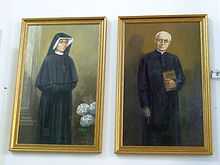Michael Sopocko
| Blessed Michael Sopocko | |
|---|---|
 Bl. Michael Sopocko | |
| Born |
1 November 1888 Nowosady, Vilnius Region |
| Died |
15 February 1975 Bialystok, Poland |
Blessed Father Michal Sopocko (November 1, 1888 in Vilnius Region, Russian Empire – February 15, 1975 in Bialystok, Poland) was a Roman Catholic priest, and professor of pastoral theology at Stefan Batory University (now called Vilnius University) in Vilnius, Lithuania.[1] He is best known as the spiritual director of Saint Faustina Kowalska.
Life
He was born Michał Sopoćko in 1888 in Nowosady near Valozhyn in Belarus.[2][3] He entered Vilnius Priest Seminary in 1910 and was ordained in 1914. He was a priest in Vilnius (1914–1918), then a chaplain in the Polish Army in Warsaw and Vilnius during World War I. After obtaining his doctorate in theology in 1926 he became the spiritual director at the seminary in Vilnius. and 1928 professor of pastoral theology at Stefan Batory University in Vilnius.
Divine Mercy

Father Sopocko was very supportive of the Divine Mercy devotion of Faustina Kowalska and in her diary (Notebook V, item 1238) she stated: "This priest is a great soul, entirely filled with God." Since 1931 Faustina had been trying (without success) to find someone to paint the Divine Mercy image until Sopocko became her confessor in the middle of 1933. By January 1934 Sopocko arranged for the artist Eugene Kazimierowski (who was also a professor at the university) to paint the image.[4][5]
On Friday April 26, 1935 Sopocko delivered the first sermon ever on the Divine Mercy - and Faustina attended the sermon.[6] The first Mass during which the Divine Mercy image was displayed was on April 28, 1935, the Sunday after Easter. Sopocko managed to obtain permission to place the Divine Mercy image within the Gate of Dawn church in Vilnius as he celebrated the Mass that Sunday.[6][7]
In the summer of 1936 Sopocko wrote the first brochure on the Divine Mercy devotion and obtained the imprimatur of Archbishop Jalbrzykowski for it. The brochure carried the Divine Mercy image on the cover.[8]
Congregation of the Sisters of the Divine Mercy
In 1942, during World War II Sopocko and other professors and students had to go into hiding near Vilnius for about two years. However, he used this time to establish a new religious congregation based on the Divine Mercy messages reported by Faustina Kowalska.[3] After the War, Sopocko wrote the constitution for the congregation and helped the formation of what is now the Congregation of the Sisters of the Divine Mercy.[3]
In an entry in her diary on February 8, 1935, (Notebook I, item 378) Faustina had written that the Divine Mercy devotion would be suppressed for some time after her death, but would be accepted again, although Sopocko would suffer for it.[9][10] In 1959 the Vatican forbade the Divine Mercy devotion and severely censured Sopocko.[11] But in 1965 Karol Wojtyla, then Archbishop of Kraków and later Pope John Paul II opened a new investigation and submitted documents in 1968, which resulted in the reversal of the ban in 1978.[10]
Until 1962 Sopocko remained a professor of pastoral theology at Vilnius University and the seminary in Bialystok, Poland. He died on February 15, 1975 in Bialystok, and was buried there. In 1988 his remains were transferred to the Church of Divine Mercy in Białostoczek Bialystok.
Quote
The decisive factor in obtaining God’s Mercy is trust. Trust is the expectation of someone’s help. It does not constitute a separate virtue, but is an essential condition of the virtue of hope, and an integral part of the virtues of fortitude and generosity. Because trust springs from faith, it strengthens hope and love, and is, moreover, linked up, in one way or another, with the moral virtues. It may, therefore, be called the basis on which the theological virtues unite with the moral. The moral virtues, originally natural, become supernatural if we practice them with trust in God’s help.[12]
Veneration
His case for beatification was started at the Vatican in 1987.[1] In 2004, Pope John Paul II issued a decree on the virtues of Father Sopocko.[2] In December 2007, Pope Benedict XVI approved of a miracle through his intercession. His solemn beatification took place on Sunday September 28, 2008 at the Sanctuary of Divine Mercy in Bialystok.
See also
| Wikimedia Commons has media related to Michael Sopocko. |
- Divine Mercy
- Divine Mercy image
- Faustina Kowalska
References
- ↑ 1.0 1.1 Odell, pp. 84-85.
- ↑ 2.0 2.1 Purest of All Lilies: The Virgin Mary in the Spirituality of St. Faustina by Donald H. Calloway 2008 ISBN 978-1-59614-195-7 page 29
- ↑ 3.0 3.1 3.2 Vatican biography of Michael Sopocko
- ↑ Torretto, pp. 84-107.
- ↑ 'Catherine M. Odell, 1998, Faustina: Apostle of Divine Mercy OSV Press ISBN 978-0-87973-923-2 pages 85-95
- ↑ 6.0 6.1 Torretto, p. 16.
- ↑ Odell, pp. 102-103.
- ↑ Odell, p. 119.
- ↑ Tim Drake, 2002, Saints of the Jubilee, ISBN 978-1-4033-1009-5 pages 85-95
- ↑ 10.0 10.1 Catherine M. Odell, 1998, Faustina: Apostle of Divine Mercy OSV Press ISBN 978-0-87973-923-2 page 153-160
- ↑ An Anthology of Christian mysticism by Harvey D. Egan 1991 ISBN 0-8146-6012-6 pages 563-565
- ↑ Sopocko, Michael, "Trust in God", Catholic Chaplaincy, University of Glasgow
Sources
- Odell, Catherine M., Faustina: The Apostle of Divine Mercy, 1998 ISBN 0-87973-923-1
- Torretto, Richard. "The Image of Divine Mercy", A Divine Mercy Resource, 2010 ISBN 1-4502-3236-1